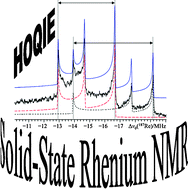Definitive solid-state 185/187Re NMR spectral evidence for and analysis of the origin of high-order quadrupole-induced effects for I = 5/2†
Abstract
Rhenium-185/187 solid-state nuclear magnetic resonance (

* Corresponding authors
a
Department of Chemistry and Centre for Catalysis Research and Innovation, University of Ottawa, 10 Marie Curie Pvt., Ottawa, Ontario, Canada
E-mail:
dbryce@uottawa.ca
Fax: +1 613 562 5170
Tel: +1 613 562 5800 ext. 2018
b
Department of Chemistry and Chemical Biology, McMaster University, 1280 Main St. W., Hamilton, Ontario, Canada
E-mail:
bain@mcmaster.ca for software enquiries
Rhenium-185/187 solid-state nuclear magnetic resonance (

 Please wait while we load your content...
Something went wrong. Try again?
Please wait while we load your content...
Something went wrong. Try again?
C. M. Widdifield, A. D. Bain and D. L. Bryce, Phys. Chem. Chem. Phys., 2011, 13, 12413 DOI: 10.1039/C1CP20572B
This is an Open Access article. The full version of this article can be posted on a website/blog, posted on an intranet, photocopied, emailed, distributed in a course pack or distributed in Continuing Medical Education (CME) materials provided that it is not used for commercial purposes.
To request permission to reproduce material from this article in a commercial publication, please go to the Copyright Clearance Center request page.
If you are an author contributing to an RSC publication, you do not need to request permission provided correct acknowledgement is given.
If you are the author of this article, you do not need to request permission to reproduce figures and diagrams provided correct acknowledgement is given. If you want to reproduce the whole article in a third-party commercial publication (excluding your thesis/dissertation for which permission is not required) please go to the Copyright Clearance Center request page.
Read more about how to correctly acknowledge RSC content.
 Fetching data from CrossRef.
Fetching data from CrossRef.
This may take some time to load.
Loading related content
